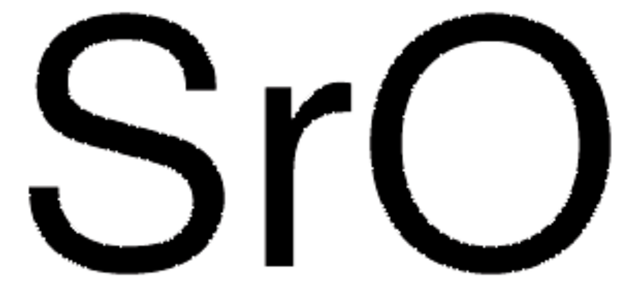517011
Strontium titanate
nanopowder, <100 nm particle size, 99% trace metals basis
Synonyme(s) :
Strontium metatitanate, Strontium titanium trioxide
About This Item
Produits recommandés
Niveau de qualité
Pureté
99% trace metals basis
Forme
nanopowder
Constante diélectrique
300
Pertinence de la réaction
reagent type: catalyst
core: titanium
Taille des particules
<100 nm
Pf
2060 °C (lit.)
Densité
4.81 g/mL at 25 °C (lit.)
Chaîne SMILES
[Sr++].[O-][Ti]([O-])=O
InChI
1S/3O.Sr.Ti/q;2*-1;+2;
Clé InChI
VEALVRVVWBQVSL-UHFFFAOYSA-N
Vous recherchez des produits similaires ? Visite Guide de comparaison des produits
Catégories apparentées
Description générale
Application
- Photoinduced electronic and ionic effects in strontium titanate: Focuses on the interaction of strontium titanate with ultraviolet radiation, investigating photoionic processes and photochromic effects, which are crucial for developing optoelectronic devices (M Siebenhofer et al., 2021).
- The emerging career of strontium titanates in photocatalytic applications: Reviews the role of strontium titanates in photocatalytic applications, particularly emphasizing their utility in environmental remediation processes (N Sharma, K Hernadi, 2022).
- Recent advances on carrier and exciton self-trapping in strontium titanate: Discusses the self-trapping of carriers and excitons in strontium titanate, providing insights into its electronic properties and implications for semiconductor technologies (ML Crespillo et al., 2019).
Code de la classe de stockage
11 - Combustible Solids
Classe de danger pour l'eau (WGK)
WGK 3
Point d'éclair (°F)
Not applicable
Point d'éclair (°C)
Not applicable
Équipement de protection individuelle
Eyeshields, Gloves, type N95 (US)
Certificats d'analyse (COA)
Recherchez un Certificats d'analyse (COA) en saisissant le numéro de lot du produit. Les numéros de lot figurent sur l'étiquette du produit après les mots "Lot" ou "Batch".
Déjà en possession de ce produit ?
Retrouvez la documentation relative aux produits que vous avez récemment achetés dans la Bibliothèque de documents.
Les clients ont également consulté
Articles
Synthesis, Properties, and Applications of Perovskite-Phase Metal Oxide Nanostructures
Notre équipe de scientifiques dispose d'une expérience dans tous les secteurs de la recherche, notamment en sciences de la vie, science des matériaux, synthèse chimique, chromatographie, analyse et dans de nombreux autres domaines..
Contacter notre Service technique






